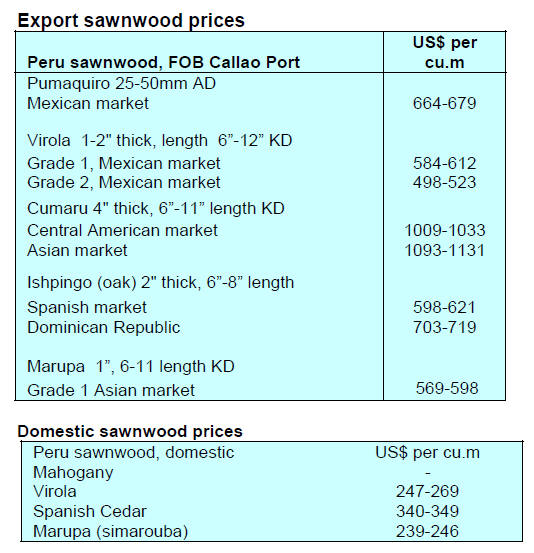4.
INDONESIA
Forestry sector performance
improving
The Secretary General of the Ministry of Environment and
Forestry, Bambang Hendroyono, has indicated that from
the beginning of July 2020 the performance of the forestry
sector has been improving. The timber sector plays an
important role in the economy as it is a major employer in
upstream and downstream sectors in Indonesia.
Bambang said the government's initiatives and support for
the sector helped alleviate the worst effects of the covid
control measures on output and support employment. The
government has reported that growth in the agriculture,
forestry and fisheries sectors recorded by Statistics
Indonesia grew around 13% in second quarter of this year.
The increased performance of forestry sector included
production logs from natural and plantation forests in the
first and second quarters of 2021 amounting to 25.6 mil.
cubic metres, an increase of about 6% compared to the
first and second quarters of 2020.
Processed wood production in the first and second quarters
of 2021 totalled 23,285,433 cubic metres, an increase of
almost 2.5% compared to the same period in 2020.
The production of Non-Timber Forest Products in the first
and second quarters was 192,269 tonnes, an increase of
48% compared to the first and second quarters of 2020.
The export value in the first and second quarters was
around US$7.5 billion, an increase of 40% compared to
the same period in 2020.
See:
https://ekbis.sindonews.com/read/557586/34/sektor-usahakehutanan-mulai-rebound-di-kuartal-iii-2020-1633187455/10
In related news Indonesian Forest Entrepreneurs
Association (APHI) noted that in the first nine months of
this year exports by downstream product manufacturers
increased 28% despite the challenges from rising shipping
costs.
Paper product exports recorded the highest value at
US$2.8 billion followed by pulp at US$2.1 billion, panels
at US$2.1 billion and wooden furniture at US$2.1 billion.
See:
https://ekonomi.bisnis.com/read/20211010/257/1452575/ekspor-industri-hilir-hutan-tumbuh-28-persen.
The Director of Forest and Plantation Products in the
Ministry of Industry, Emil Satria, is confident on the
growth of furniture exports as this sector has proven to be
resilient despite the pandemic.
The Ministry of Industry noted that in the first eight
months of this year furniture exports (HS code 9401-9403)
reached US$1.61 billion, a 36% rise from the same perios
in 2020. Data was not provided on how the 2021 exports
compare to those in 2019 before the pandemic.
See:
https://bisnis.tempo.co/read/1515667/kemenperin-targetkanekspor-furnitur-tembus-rp-284-triliun-tahun-ini/full&view=ok
SMEs to get help upgrading machinery
The Acting Director General of Small and Medium Scale
Industry in the Ministry of Industry, Reni Yanita, said the
ministry is working to upgrade the machinery used by
small and medium-scale furniture industries to improve
productivity as well as quality so as to create export
opportunities for these industries.
The Ministry plans to partly reimburse SMEs that buy
machinery during the period of the plan. The ministry will
provide 25% for imported machine and 40% for locallymade
machines.
See:https://en.antaranews.com/news/191149/industry-ministryoptimizes-furniture-machinery-restructurization
Breakbulk cargo shipments
The Deputy Minister of Environment and Forestry, Alue
Dohong in a meeting with the media, reported that a
private company exported plywood and blockboard to
United States using breakbulk shipping.
The press reported Alue as saying "It turns out that the use
of breakbulk is more efficient and 50% cheaper than
shipment using containers." The Deputy Minister urged
other companies to explore this shipping option.
In related news, the Chairman of the Indonesian Furniture
and Craft Industry Association (HIMKI), Abdul Sobur,
responded to the suggestion by the Minister of Trade that
furniture exporters should utilise air freight when shipping
containers are not available.
Sobur said Indonesian furniture products were mostly
large sized and as such not all types of furniture can be
shipped profitably by air. Since the end of last year, the
furniture industry has been suffering increased shipping
costs especially for transcontinental shipments.
See;
https://www.msn.com/id-id/ekonomi/bisnis/ongkospengapalan-naik-900-persen-industri-mebel-sulit-beralih-kekargo-udara/ar-AAP6AAP?ocid=BingNewsSearch
and
https://www.antaranews.com/berita/2415465/inovasi-breakbulktingkatkan-daya-saing-plywood-indonesia
A commitment to sustainable trade
In a press release the government reaffirmed its
commitment to supporting and implementing a sustainable
trade by signing a memorandum of understanding with the
Global Initiative Report through the launch of a
'Sustainability Reporting for Responsible Business in
Indonesia.'
The Director General of National Exporst in the Ministry
of Trade, Didi Sumedi, said Indonesia has shown a
commitment to sustainable trade. One of which is for the
sustainable trade in wood products through the timber
legality verification system (SVLK) which is recognised in
Europe.
The collaboration with the Global Initiative Report is
expected to help SMEs improve their understanding of
sustainability aspects in their business processes.
See:
https://pressrelease.kontan.co.id/release/gandeng-globalinitiative-report-kemendag-berkomitmen-dalam-sustainabletrade

5.
MYANMAR
Declining timber exports
According to data released by the Ministry of Commerce
timber exports are declining. The value of timber exports
reached at US$175 million in 2018-19, US$154 million in
2019-20 and US$116 million for the 11 months of 2020-
21.
Verification o
f legality is one of the major causes of the
decline followed by the effect of pandemic control
measures and political developments. Timber exports were
stalled for the three months of April, May and June 2021
as a result of a review of export regulation by the new
administration. Then the US and EU imposed restrictions
on trade handled by the Myanma Timber Enterprise
(MTE), the state-owned enterprise responsible for
suppling of log to mills in the country.
Since MTE is sole organisation to supply the logs to mills
the trade restrictions are having a serious impact on the
timber industry.
Exchange rate nose dives
Myanmar's currency, the kyat, is at an all-time low.
Against the US dollar the Kyat was trading at 1,395 in
February, it dropped to 1,695 in September and in mid-
October stood at 2,700 to the dollar. The depreciation will
make it hard for the administration revive the country's
economy.
Manufacturing sector attracts most investment
The Directorate of Investment and Company
Administration has reported that the majority of foreign
enterprises investing in Myanmar in the last financial year
2020-2021 opted for the manufacturing sector and
invested around US$290 million in 27 projects.
Manufacturing enterprises create jobs so are prioritised
according to the Myanmar Investment Commission.
Currently, labour intensive businesses are facing very
challenging conditions due to the pandemic and the
political situation.
6. INDIA
Rising raw material costs for timber
industry yet to
impact wholesale indices
The Ministry of Commerce and Industry has reported the
official Wholesale Price Index for ‘All Commodities’
(Base: 2011-12=100) for August 2021 increased to 135
from 132 in July 2020.
The index for manufactured products which accounts for
almost 65% of the overall index, increased to 133.0 in
August 2021 from 132.0 for July 2021. Out of the 22
groups of manufactured products, 14 saw increased prices;
6 groups witnessed a decline and for two groups the prices
remained unchanged in August 2021 as compared to July
2021.
The increase in prices was mainly contributed by the
manufacture of basic metals; food products; chemicals and
chemical products; electrical equipment and textiles. The
recent rise in costs of raw materials for the wood
processing industry is expected to appear in the September
and October indices.
The press release from the Ministry of Commerce and Industry
can be found at:
http://eaindustry.nic.in/cmonthly.pdf
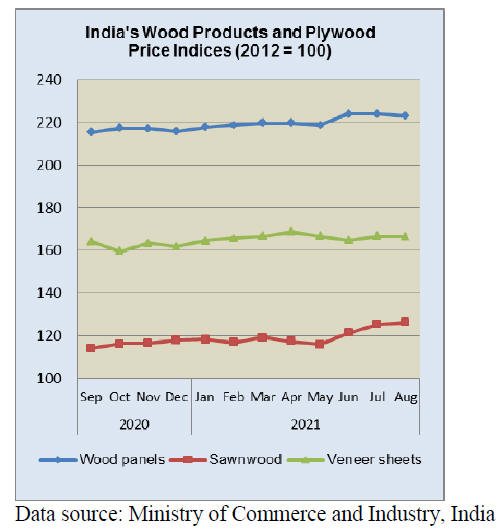
The press release from the Ministry of Commerce and
Industry
can be found at:
http://eaindustry.nic.in/cmonthly.pdf
Firm signs of economic recovery
In its report on the economy for September the Ministry
Finance said India’s economy has started to strengthen as
the second wave of infections ebbed. Citing a rise in
industrial output and modest inflation India on a path to
recovery. Sustained agriculture output, the rebound in
manufacturing and resumption of services are all positive
indicators. In parallel to growth signals bank credit growth
improved in September.
See:
https://www.thehindu.com/business/Economy/indiaseconomic-recovery-at-90-of-pre-pandemic-level-in-septemberfinance-ministry/article36938469.ece
Home buyer confidence to lift housing growth
There was firm growth in the Indian residential and
commercial property sectors in the third quarter of this
year as the country slowly began to return to normal due to
the efficient vaccination programme. Record-low home
loan interest rates and other benefits offered by real estate
companies helped lift demand after the decline in the
second quarter.
Looking ahead, Kailash Babar writing in the Economic
Times of India, says the real estate sector could see
sustained growth in the coming quarters on the back of
renewed buyer confidence.
See:
https://economictimes.indiatimes.com/industry/services/property-/-cstruction/brick-by-brick-indian-real-estate-market-is-climbingout-of-the-covidhole/articleshow/86769925.cms?utm_source=contentofinterest&utm_medium=text&utm_campaign=cppst
Teak logs and sawnwood
Freight rates for logs and sawnwood are showing no signs
of easing. Importers are saying that in some cases the cost
of feight per unit volume is higher than the cost of the
timber.
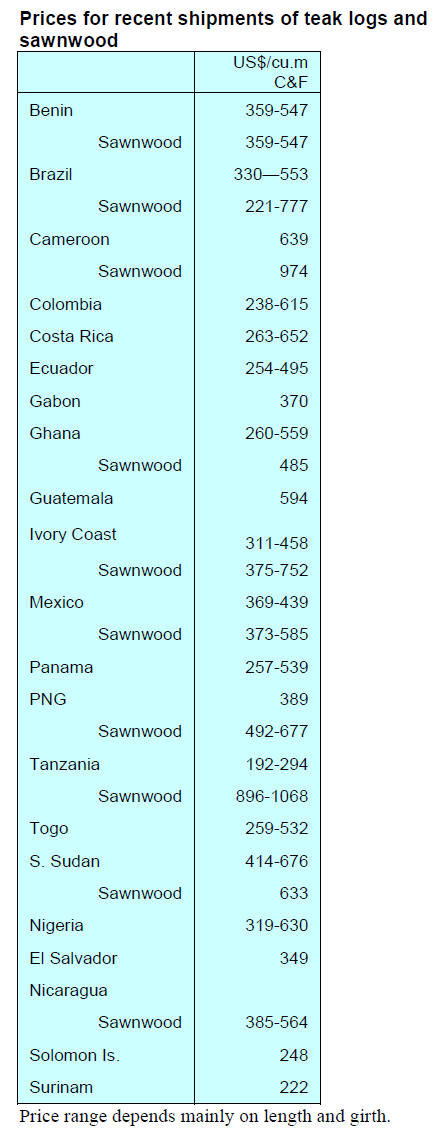

Plywood production costs rising
Despite the recent increase in plywood prices plywood
manufacturers are struggling with rising production costs.
The high cost of credit, slack order flow and increased
prices for raw materials including logs and veneer,
formaldehyde, preservatives, phenol and shuttering base
paper are challenging the sector.
Poplar log prices have jumped around 25% in a few
months driven higher by the drop in harvesting as workers
had to stay home.
See:
https://www.tribuneindia.com/news/haryana/yamunanagarplywood-industry-struggles-hard-for-survival-313591
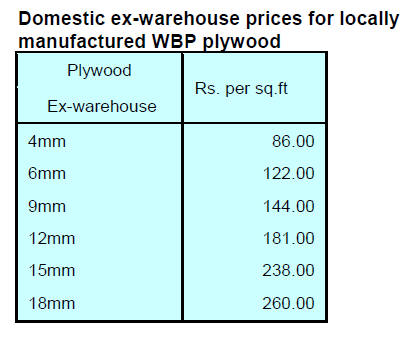
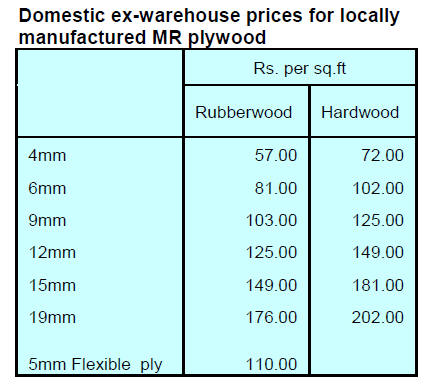
7.
VIETNAM
USTR agreement to resolve timber
investigation
Through a press release quoted below the United States
Trade Representative, Katherine Tai, announced an
agreement with Vietnam that addresses U.S. concerns in
the Vietnam Timber Section 301 investigation. This is the
first 301 investigation to address environmental concerns.
“The Agreement secures commitments that will help keep
illegally harvested or traded timber out of the supply chain
and protect the environment and natural
resources. Ambassador Tai determined that the
Agreement provides a satisfactory resolution of the matter
subject to investigation and that no trade action is
warranted at this time.
Going forward, the Office of the U.S. Trade
Representative (USTR) will monitor Vietnam’s
implementation of the Agreement.
“I commend Vietnam for its commitment to address our
concerns regarding the importation and use of timber that
is illegally harvested or traded,” said Ambassador
Katherine Tai.
“With this Agreement, Vietnam will provide a model –
both for the Indo-Pacific region and globally – for
comprehensive enforcement against illegal timber. USTR
looks forward to working with Vietnam to deepen
collaboration and information exchange, including through
a newly created Timber Working Group.”
The Agreement contains multiple commitments by
Vietnam on issues related to illegal timber, including
commitments to improve its Timber Legality Assurance
System; keep confiscated timber (i.e., timber seized for
violating domestic or international law) out of the
commercial supply chain; verify the legality of
domestically harvested timber regardless of export
destination; and work with high-risk source countries to
improve customs enforcement at the border and law
enforcement collaboration.
“Illegal timber in the supply chain damages the global
environment and the natural resources on which we all
depend, and is unfair to U.S. workers and businesses who
avoid such timber,” added Ambassador Tai.
“USTR’s first use of Section 301 in this investigation
shows the strength of using this tool to address concerns
regarding environmental risks or the enforcement of
environmental laws.”
The USTR investigation was initiated in October 2020
under Section 301 of the Trade Act of 1974. The full text
of the Agreement is available here. The Federal Register
notice summarizing the Trade Representative’s
determination provides additional background”.
See:
https://ustr.gov/about-us/policy-offices/press-office/pressreleases/2021/october/ustr-announces-agreement-betweenunited-states-and-vietnam-resolve-timber-section-301-investigation
Vietnam’s wood products trade highlights
Vietnam’s W&WP exports to Japan in September 2021
were valued at US$90 million, down 17% compared to
September 2020. In the first 9 months of 2021 the exports
of W&WP to Japan totaled at US$1.02 billion showing an
increase of 10% over the same period in 2020.
However, due to the Covid-19 fourth outbreak, W&WP
export to Japan declined beginning in August. W&WP
exports to Japan are expected to recover in the last quarter
of 2021 as the Government eases social distancing and
lockdowns allowing the resumption of production.
Wooden furniture exports have grown an average 17% per
year since 2016. In the first 8 months of 2021 the
accumulated export earnings from wooden furniture
exports reached US$7.25 billion, an increase by 48% over
the same period in 2020.
Softwood wood imports into Vietnam in September 2021
were estimated at 123,900 cu.m, worth US$32.8 million
up 4.4% in volume and 2% in value compared to August
2021. Compared to September 2020 softwood wood
import increased by 49% in volume and 78% in value.
In the first 9 months of 2021 softwood wood imports were
reported at 1,132 million cu.m, worth US$267.3 million,
up 83% in volume and 104% in value over the same
period in 2020.
In September 2021, the Covid-19 epidemic continued to
be complicated across the country and greatly affected the
production and business operation of all enterprises.
Following 15 months of continued increase the exports of
rattan, bamboo and other types of NTFPs in September
2021 declined to US$50 million, down 9% compared to
the same period in 2020.
In the first 9 months of 2021 exports of all NTFPs were
valued at US$631.6 million, up 50% over the same period
in 2020.
Exports to Japan falling for the second month
In September 2021 Vietnam’s exports of W&WP to the
Japanese market were valued at US$90 million, down 17%
compared to September 020.
In the first 9 months of 2021 W&WP export to Japan
totalled at US$1.02 billion, an increase of 10% over the
same period in 2020. Due to the Covid-19 control
measures in Vietnam W&WP exports to Japan declined in
August and September. However, a recovery of trade is
anticipated in the last quarter of the year as the
Vietnamese government eases control measures.
In the first 8 months of 2021 of the W&WP exports to
Japan wooden furniture was the main item valued at
US$341 million, up 1% over the same period in 2020.
Guest-room and dining-room furniture topped exports
with the revenue of US$928 million, up 7% over the same
period in 2020 followed by wooden-frame seats (US$81
million, up 7%) and bedroom furniture (US$64 million,
down 16%).
After wooden furniture were woodchip exports valued
US$ 325 million, up 26% over the same period in 2020.
Joinery panels and floorings, as the third WP group
contributed US$117.3 million, up 27%.
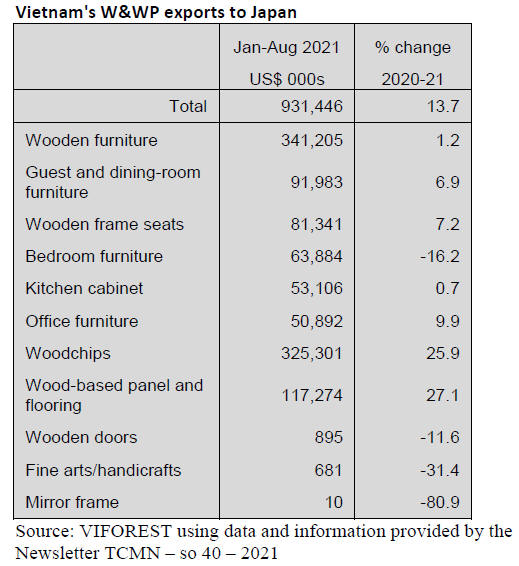
Price of imported softwood wood
The average price of imported sawn softwood in the first 8
months of 2021 was US$264/cu.m, up 10.4% over the
same period in 2020.
In particular, the price of sawn softwood imported from
Brazil increased by 21% to US$248/cu.m; from Chile by
23% to US$273/cu.m; from New Zealand by 23% to
US$95.4/cu.m; from the EU by 24% to US$263/cu.m.
In the first 8 months of 2021, Vietnam imported 794,000
cu.m of sawn softwood worth US$210 million, up 65.6%
in volume and 97.5% in value over the same period in
2020.
Imports of softwood logs were reported at 212,400 cu.m,
worth US$23.5 million, up 278% in volume and 252% in
value over the same period in 2020. The average price of
softwood logs imported into Vietnam was US$110.8/cu.m.
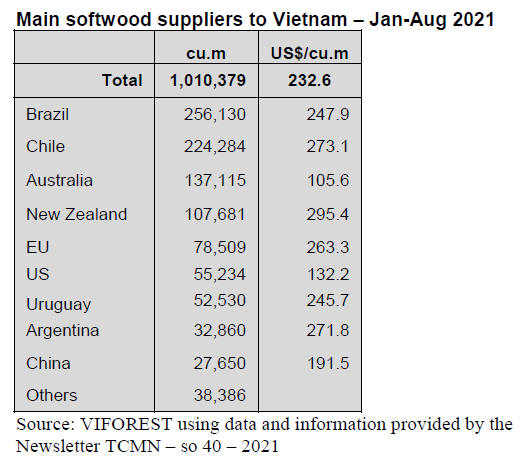
8. BRAZIL
Companies commit to fighting climate
change
The Brazilian Business Council for Sustainable
Development (CEBDS) presented the Ministry of
Economy a document titled ‘Entrepreneurs for the
Climate’ which was signed by over 100 private sector
entities in which they defend a low carbon economy and
take responsibility for implementing change.
At the time the document was delivered the business
community highlighted the opportunities generated from a
sustainable business model such as job and income
generation and how the action by the private sector is
essential for the country to achieve its goal of reducing
greenhouse gas emissions.
The CEBDS brings together around 80 of the country's
largest business groups responsible for 47% of the
Brazilian GDP and 1.1 million jobs. Thirteen of the fifteen
largest companies by market value in the country are
members of CEBDS.
In related news, a study ‘Opportunities for Brazil in
Carbon Markets’, produced by the Brazil International
Chamber of Commerce (ICC) shows that the carbon
market has a potential to generate revenues of up to
US$100 billion by 2030 as well as creation of employment
opporunities.
Floresta+ programme now includes bioeconomy
The Floresta+ Program has a new feature, Foresta+
Bioeconomy aimed at payments for the provision of
environmental services by those who preserve the
environment. The idea of this new programme is to raise
awareness among buyers of extractive products of the
contribution that these workers make to the preservation of
forests.
The Forest+ Program has among its objectives:
Recognition of the direct contribution of
sustainable forest management activities, whether
timber or non-timber, for the protection of forests
The creation of commercial arrangements and
encouragement of innovation to highlight,
recognize and remunerate the environmental
services performed by those who work in forest
conservation
Encouraging timber and non-timber forest
production from natural forests in Brazil,
fostering innovation, structuring and development
of this chain through Payment for Environmental
Services
Encouraging remuneration for monitoring,
conservation and recovery activities of natural
vegetation, enabling the guarantee of income,
generating stability and incentives for the
maintenance of forest areas
Business actions that have the potential to
enhance the market for payments for
environmental services.
Furniture exports
In August 2021 the furniture sector in Brazil exported
more than US$75 million (FOB). This represented an
increase of over 30% when compared to August 2020.
This success demonstrates the consistent performance of
the furniture sector and shows Brazilian products are
gaining market share in international markets. Wooden
furniture accounted for most of the exports and was worth
US$63 million.
The main export market for Brazilian made wooden
furniture is the United States which accounted for over a
third of exports followed by Chile at 15%.
Timber industries resume shipments from Port of Vila
do Conde
The refusal by wood product exporters to ship through the
Vila do Conde Port in Barcarena a municipality in the
state of Pará which is one of the largest tropical timber
exporting states in Brazil was recently lifted.
This decision was made after commitments by the Port
authorities to streamline and reorganise the system for
processing export documents so as to avoid unnecessary
delays. Unfortunately it has been estimated that it will take
around three months to clear the backlog of export
shipments.
The refusal to use the Port by the timber sector was called
not only because of the delays in issuing export
authorisations but also because of the lack of an efficient
inspection service, excessive bureaucracy, high customs
fees and because IBAMA did not have a presence at the
Port .
IBAMA has informed that the problem in issuing export
authorisations was due to the decision of the Federal
Supreme Court (STF) which was issued without a deadline
for IBAMA to adapt to the regulatory effects of the
judicial measure and that this led to the disruption in
document processing. IBAMA has been discussing with
the exporters the consequences of the court decision that
increased the demand for documents for export procedures
of timber from natural forests.
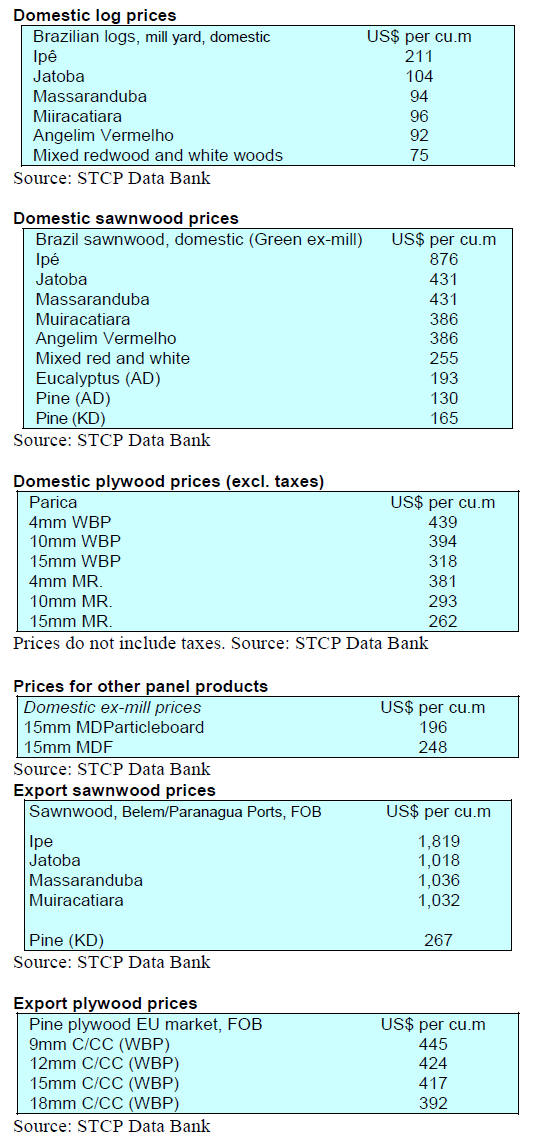

9. PERU
‘Yacu Kallpa’ case concluded
In late September Peruvian prosecutors filed charges in
the Yacu Kallpa case named after the ship that carried
illegally harvested wood from the forests of Iquitos to
Houston, Texas.
Charges were brought against 14 people in export
companies, 38 logging concession owners and 41 former
Peruvian officials. They have been charged with crimes
that include the illegal granting of rights and illegal timber
trafficking.
See:
https://ojo-publico.com/3046/yacu-kallpa-90-funcionarios-yempresarios-acusados-por-tala
Exports higher but not yet at 2019 levels
Wood product exports reached US$77 million in the first
eight months of this year a figure that indicates a growth
of almost 40% compared to the same period in 2020
(US$50 million) however, export earnings have not yet
reached the same level as seen in 2019 (US$80 million).
This was reported by the Association of Exporters
(ADEX) who pointed out that demand was highest for
semi-manufactured products (US$47.5 million),
highlighting mouldings, slats and friezes for unassembled
parquet and other profiled products.
Exports of sawnwood (US$18.8 million), construction
products (US$4.5 million), furniture and parts (US$2.7
million), veneer and plywood (US$1.7 million),
manufactured products (US$0.8 million) were also
exported.
The main destination was China, with a 31% share,
followed by France (17%) and the United States (12%).
Mexico, the Dominican Republic, Denmark, Belgium,
Vietnam, New Zealand and Ecuador complete the top ten.
Remote monitoring project
It has become a challenge to ensure the monitoring of
forests in Peru while complying with social distancing.
Since March the US Forest Service has been providing
technical assistance to OSINFOR (Agency for Supervision
of Forest Resources and Wildlife) for the design and
implementation of a remote forest monitoring system.
This initiative has also involved the World Resources
Institute (WRI) and the University of Sheffield to test in
Peru an algorithm to detect and monitor selective logging
activities in the rainforest using satellite imagery.
Recently the university refined and adapted its algorithm
for Peru and training sessions will be held in October for
OSINFOR staff to use it.
As part of the preparatory activities OSINFOR held a
workshop to identify and generate consensus around the
technical and institutional support requirements required
to use remote sensing technologies in the supervision
processes for qualifying titles.
The main objective of the workshop was to strengthen
capacities for the development of the project roadmap,
optimise institutional performance and ensure the financial
sustainability of this initiative.
Peru to be one of fastest-growing economies in Latin
America
The International Monetary Fund (IMF) has forecast
Peru's GDP growth will be 10% this year making Peru one
of the fastest-growing economies in Latin America. This
growth, says the IMF will be because of higher prices for
metal exports.
According to its latest World Economic Outlook, Latin
America's economic growth for this year will be 6.3%,
half a point above what was considered in July (5.9%),
mainly due to the good performance of the commodity
export sector.
Vaccination roll-out up-date
The Ministry of Health has reported that 46% of the target
population for COVID-19 vaccination in Peru has received
the two doses that prevent severe cases. As of early
October 29,761,806 doses have been administered in Peru.
Out of that total, 16,870,122 were administered to first
dose recipients, while 12,891,684 as second shots.
